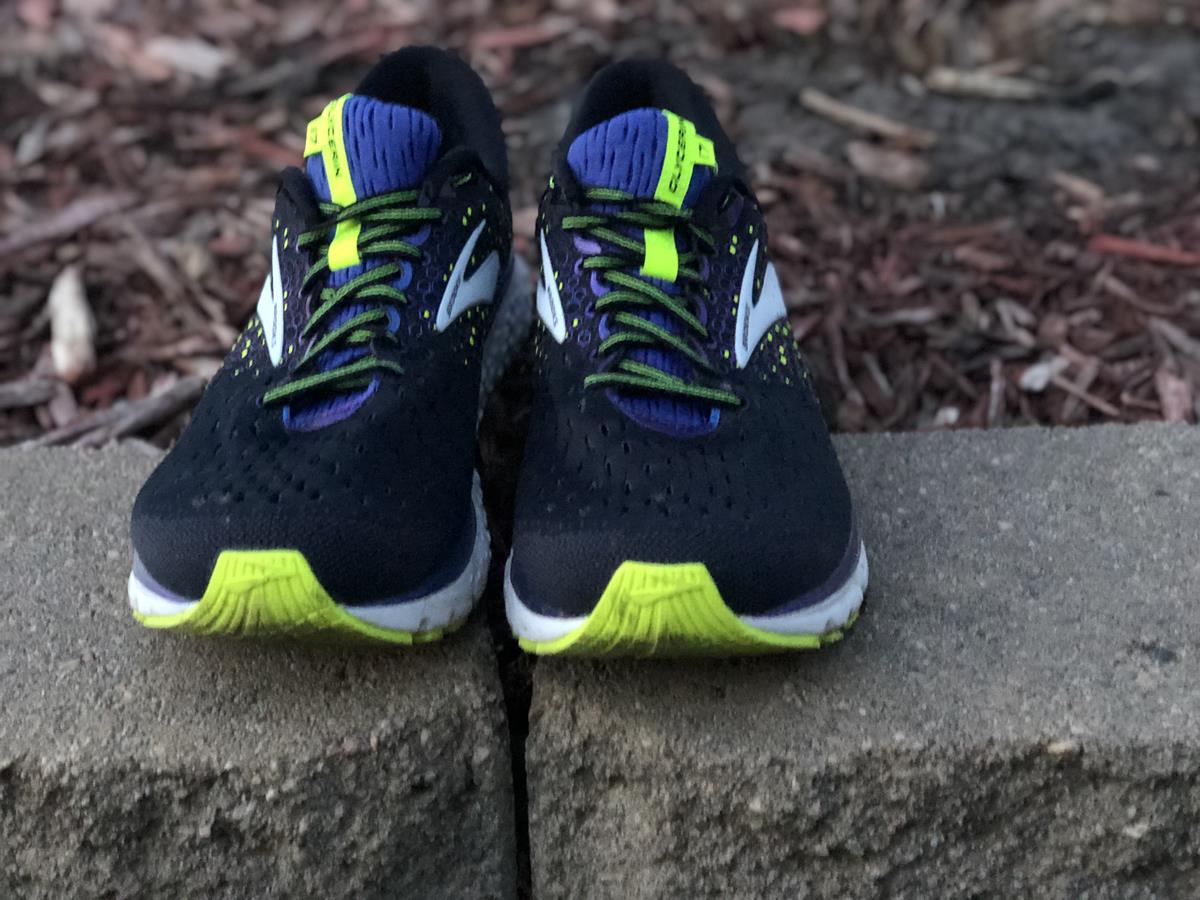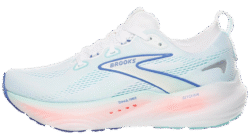Brooks Glycerin 17 Intro
As max cushioned trainers become more and more popular and sought after, there are some options that distinguish themselves above the rest.
A few of those are the ASICS Nimbus, Saucony Triumph, Nike Vomero, Adidas Ultra Boost and the Brooks Glycerin. Each of these offerings have multiple years of the models and it seems that each year they are very different.
However, Brooks didn’t seem to take that route with the Glycerin 17s, as it feels like the same shoe with a slightly different look.
Brooks Glycerin 17 First Impressions


Brooks Glycerin 17 – Toe
The Brooks Glycerin 17s represent the top level of traditional neutral trainer from the Brooks line.
They are the flagship neutral trainer, and it is impossible to run a distance race and not see someone laced up in these shoes — heck, it’s the go-to shoe for Des Linden.
Knowing how well received the Glycerin 16s were, with a complete update, Brooks decided to “not mess with a good thing” and didn’t really touch the shoe very much. Fans of the 16s will love that the company didn’t change much.
They will compete against the other max-cushion neutrals; Nimbus, Triumph, Vomero and New Balance 1080s.
They are all in the same relative price range so it can be difficult to decide on a pair to purchase. Each of these shoes has its reason for being purchased, and the Glycerins come in as one of the more well rounded options.
When they showed up, I really liked the new look of the upper. The redesigned heel cup felt and looked good. When they first went on my feet.
I was happy with the cushion level and they were awesome for the all-day wear test, but I was struck by how similar they felt in side-by-side wear of the 16s. On their first run, they were great.
Brooks Glycerin 17 Sole Unit


Brooks Glycerin 17 – Sole
The sole unit on this shoe offers the same cushion level as last year, because it is the same sole unit.
The midsole of the shoe uses Brooks’ patented the newer DNA Loft foam, which incorporates air and rubber to their previous foam formula of DNA foam.
This foam is advertised as softer and lighter while not losing responsiveness and durability, which I can attest to having experienced it in a few Brooks offerings.
The DNA Loft foam performed very well, and held up to a half marathon practice run without any breakdown and keeping my feet feeling fresh.
With a high stack height of 32mm at the heel and 22mm at the forefoot, there is plenty of material under foot. Also that 10mm drop, although traditional, is beginning to be a bit steep for some runners.
In the midsole, Brooks continues to use grooves as a way to increase the flexibility and help with the responsiveness of the material.
It results here in a max-cushion shoe that doesn’t feel clunky, but instead feels connected to the ground and helps push forward.
As is usual with the Brooks (and anymore, any running shoe) design, the shoe ends with an aggressive upturn on the toe. This allows you to roll into your next step.
The outsole uses HPR Plus rubber, a high abrasive rubber material, on the heel of the outsole that helps the durability and helps absorb impact from heel-strike runners.
As a midfoot striker, I did not really notice this material, however I have friends who rave about the inclusion of the heel strike zone.
Brooks uses a blown rubber outsole for the forefoot. This is a proven material that is durable while staying lightweight and is flexible. When combined with the midsole design, it allows for a flexible max-cushion shoe.
The ride of the sole unit is smooth. There is ample cushion for the long runs, while still being responsive enough that you can run your tempos in them and feel fine.
As a mid-foot or fore-foot striker, the cushion and rubber was enough that I never felt a jarring impact but kept things going.
However, just as with the 16s, the cushion and how plush the forefoot area of the sole resulted in me feeling as though I sank into the cushion when I tried using them for track workouts.
On the road, and even up to tempo or long-distance race running, they are great. But make no mistake, these shoes were not designed for your 400m repeats.
Last year, with the 16s, I had the complaint that the insole of the shoe moved quite a bit. This was especially true while running in wet conditions.
With the 17s, they seem to have used a better adhesive on the insole, and I did not experience this negative at all during all my runs. I appreciate them fixing this issue.
Brooks Glycerin 17 Upper Unit


Brooks Glycerin 17 – Top
The Glycerin traditionally is known for running slightly small, however, mine fit true to size as a size 13. The heel fit snug but not tight, and the midfoot was supported but not pressed.
These components widened out into a very comfortable toebox. This area would not be confused with that of an Altra offering, but my toes felt comfortable in each run that I wore the Glycerins.
The upper is where Brooks decided to make some updates. Although they kept most of the upper from the 16s, including a mesh upper for breathability while utilising 3D printed overlays to support your foot.
This year, they redesigned their sock liner to add extra comfort inside the upper.
Well Brooks continues to use a dual layer mesh to allow for breathability but help keep dirt out of the shoe and offer a little support.
These two layers, however, can also result in a lot of moisture being trapped during rain runs. Although they dried out quicker than last year’s model, they can still get weighed down and heavy during those runs.
Brooks adds support over the arch by continuing to use 3D printed overlays, which add structure to the upper itself. This year these overlays also add a new design look that I found quite fetching.
One of my favorite features from the 16s is still present in the new model as they kept the overly plush collar.
It seems to me that often shoe companies overlook the collar of their shoe and that is where you develop irritation on your long runs. Or a company may do some gimmicky thing as an afterthought on their collar.
That isn’t the case with Brooks. They design the upper all the way around, and there was no overlooking the collar, as it comfortably wraps your foot and ankle. Very nice.
As stated before, the only real update to the shoe was the inclusion of a new OrthoLite sock liner to the interior of the upper.
This new sock liner is much softer than that in the 16s and I decided I needed to try it without socks at least a couple of times to see how it felt.
The upper was soft and comfortable, and at no point did I feel it rubbing my feet or making me uncomfortable. So for you non-sock runners, this shoe can get the job done.
Brooks Glycerin 17 Conclusion


Brooks Glycerin 17 – Pair
In the end, there is a reason that the Glycerin is the flagship of the Brooks neutral offerings. The combination of technologies results in a shoe that you can’t help but enjoy using.
Beyond that, this shoe — as with all Brooks shoes I’ve tested — seems to be built to last. After putting more than 175 miles on them, they still feel and look newer than they really are.
These shoes still have a lot of life left in them, and I have not been treating them nicely.
As I’ve said before, this is something I would hope would be true for this level of shoe, but it doesn’t always seem to be the case.
At a price point of $150 on a pair of trainers, you want to know you’re going to get your money’s worth (300-500 miles) All signs point to that being the case and that these shoes, bringing value at the price point.
If you’re looking for that shoe to use for going long, or you’re getting into the sport for the first time, it might be worth dropping the money on some of the most famous trainers available.
They are so popular and readily available for a reason. And in this case, I’d recommend them to almost anyone.
We purchased a pair of Brooks Glycerin 17 from runningwarehouse using our own money. This did not influence the outcome of this review, written after running more than 50 miles in them.
Brooks Glycerin 17 Price Comparison
This page contains affiliate links. As an Amazon Associate I earn from qualifying purchases.






































